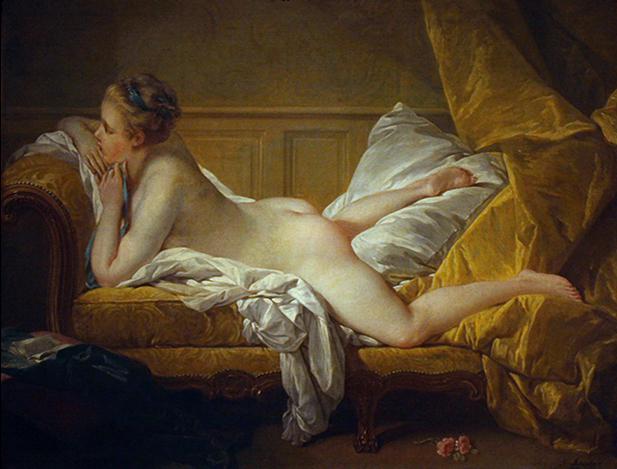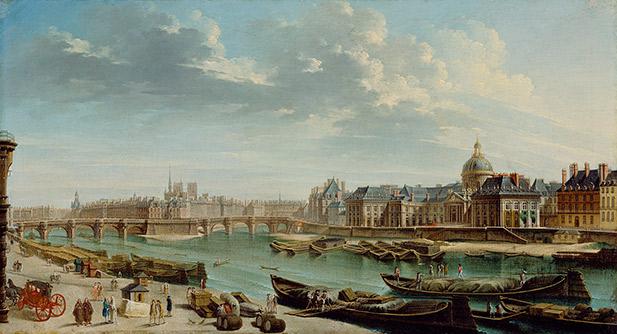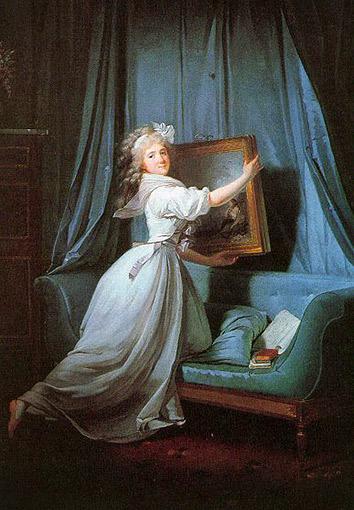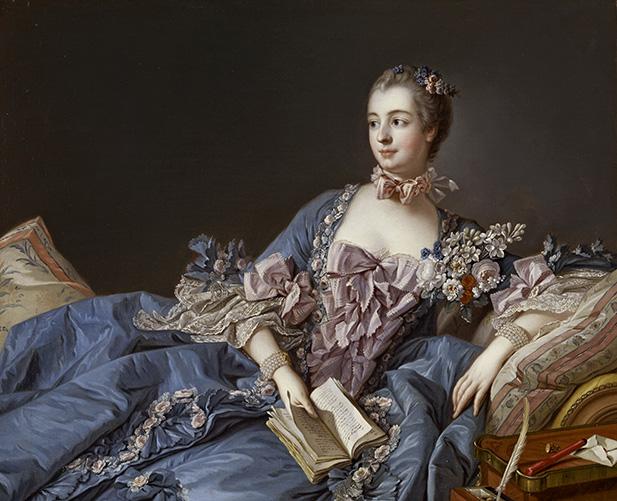Visualizing the Revolution Politics and Pictorial Arts in Late Eighteenthcentury France
The Case of the Closely Watched Courtesans
The French police obsessively tracked the kept women of 18th-century Paris. Why?

Painting by François Boucher. Image courtesy of Wallraf-Richartz-Museum/Creative Eatables
An hour with a prostitute costs on average $150, though prices can range from as low every bit $5 for a single sex act to $1,000 an hour, the going rate for "high-end" online escort services in Miami. Many of those in the sex trade were encouraged past family members to take up sex piece of work. Pimps rely as much if not more on emotional manipulation than physical violence to command their sex workers.
These are some of the findings of a recently released study by the Urban Plant describing the structure of the underground commercial sexual economy—street and Net prostitution, escort services, massage parlors, brothels, and child pornography—in eight major cities across the U.Southward. Funded by the National Found of Justice, the report is unprecedented in its scope and depth: It volition surely change how both lawmakers and law enforcers think about the sex activity trade and shape their approaches to control it.
Trying to empathize the underground sexual practice economy, nonetheless, is equally old as law piece of work itself. One of the very beginning police forces in the Western earth emerged in 18th-century Paris, and i of its vice units asked many of the same questions every bit the Urban Institute authors: How much practise sexual practice workers earn? Why practice they plough to sex work in the beginning place? What are their relationships with their employers?
And nonetheless, unlike the Urban Institute researchers, who undertook their study in the hope that a better understanding of how this underground economy functions might pb to better public policy, this Parisian vice unit had more nebulous motives. Its inspectors compiled vast dossiers of information on the urban center'south elite sex workers and their patrons. Merely they rarely acted on that information. To this twenty-four hours, it remains a mystery why the Parisian police spent so much time and attempt observing an undercover economic system it patently had no involvement in curtailing. But their files are an historian's dream. They pigment a vivid portrait of xviiith-century Parisian life and offer a particularly fascinating view of the urban center's elite sex workers, who had greater social mobility than most women in that period.
* * *
The focus of this item vice unit of measurement was the demimonde, the world of elite prostitution. The policing of street prostitution and brothels that catered to men of little means were left to other police personnel, who were far more aggressive in their tactics. They apprehended street prostitutes and those who worked in taverns. They raided and shut downwards brothels, bringing all those arrested women—prostitutes and petty madams alike—to police court where they were tried en masse and so taken, heads shaved, to serve time in Paris' famous women's prison, La Salpêtrière.
Aristocracy prostitution was treated differently. Certain brothels that catered to the male person elite were immune to operate. Information technology was one duty of the vice unit'south inspectors to make certain the madams of these "authorized" brothels abided by sure rules, one of which was to supply the inspectors with a steady stream of information. But most of the unit of measurement's energy was spent watching a particular group of elite prostitutes that worked as professional person mistresses. Chosen kept women (the French term is dames entretenues), these women (and girls) provided sex, company, and sometimes even love for elite men in exchange for being "kept," financially supported and then that they could establish and maintain a household. La galanterie, the do of being or keeping a mistress, was not illegal, even while prostitution was.

Painting past Nicolas-Jean-Baptiste Raguenet. Prototype courtesy of J. Paul Getty Museum/Creative Eatables
The vice unit, which operated from 1747 to 1771, turned out thousands of hand-written pages detailing what these dames entretenues did. Being kept in the 18th century was non a profession in the modern sense of the term, simply information technology was a job. What was sold was standardized: sexual practice, visitor, the pretense of affection, and unremarkably the illusion that the patron was the center of the mistress's world. Kept women had oral contracts with their patrons, which stipulated how much the mistress would exist paid each month, and whether the patron would set up his mistress up in an flat, buy her new furnishings, pay her bills, and requite her gifts. The mistress' duties were not delineated but rather were "understood," leaving a groovy deal of room for misunderstanding.
In following kept women nearly Paris, the police, much like the authors of the Urban Institute report, were interested in every aspect of these women'due south professional and personal lives, from their entry into sexual practice piece of work to the intimate details of their relationships with their patrons. They gathered biographical and fiscal data on the men who hired kept women—princes, peers of the realm, army officers, financiers, and their sons, a veritable "who's who" of high gild, or le monde. Assembling all of this data required cultivating all-encompassing spy networks. Making information technology intelligible required certain bureaucratic developments: These inspectors perfected the genre of the report and the information management system of the dossier. These forms of "police writing," equally one scholar has described them, had been emerging for a while. Merely they took a giant leap forward at midcentury, with the piece of work of several Paris constabulary inspectors, including Inspector Jean-Baptiste Meusnier, the officer in accuse of this vice unit of measurement from its inception until 1759. Meusnier and his successor also had clear literary talent; the reports are extremely well written, replete with irony, clever turns of phrase, and even narrative tension—at times, they read similar novels.
* * *
Here is an example. In 1752, Inspector Meusnier wrote a study near a woman named Demoiselle Blanchefort. It was the first of at to the lowest degree twenty that came to make up her file, covering more than a decade of her life in elite sexual activity work. The starting time report was a sort of back history, which the inspector tried to gather on most of his subjects. It explained how the discipline under surveillance came to be an elite prostitute. Blanchefort, Meusnier wrote, was the daughter of a surgeon in Angers, a city in western France. Surgeon in this period was non yet a high-status profession. It was closer to the artisan than the professional person, still linked in popular thinking with hairdresser—the scarlet and white strips of the barber's pole represented the blood and bandages once associated with the trade. Blanchefort, like most kept women, was from the lower center of the social spectrum. The inspector did not seem to know her real proper name, or how or why she came to Paris, but he was able to trace her once she became an elite sex worker at the brothel of Madam Carlier, where she took the name "Victoire." Victoire was not a virgin, claimed Meusnier. Brothels were not supposed to take virgins equally workers, though they ofttimes did and with police cognizance. The report, as with most reports, justified why information technology was permissible, in the country'south eyes, for Blanchefort to be a prostitute. Her virginity gone, she was "ruined," theoretically unfit for union.
Meusnier goes on: At Carlier's, Blanchefort met an regular army officeholder who pulled her out of the brothel to set her upward as his mistress. This was a common practice; customers oft met their time to come mistresses at these establishments. To have Blanchefort, the army officer had to pay all of her debts, which could exist significant. Debt was one mode the madams bound sex activity workers to them, compelling them to stay in the brothels to work. Some workers arrived with debt the madams assumed. Others borrowed coin from the madams to pay for their food and clothing and particularly for medical care, the price of which could easily exceed a prostitute'southward earnings.
According to Meusnier, Blanchefort had some sort of crabs infection. The ground forces officer had her see his company surgeon, and Meusnier reports that the couple was "happy." But within a few months, the officer had to leave town, ending the relationship when he did. Emphasizing the transactional nature of these affairs, many patrons would not pay for a mistress they could not visit. To brand ends see, Blanchefort eventually went back to work in a brothel, this time that of the infamous Justine Paris, whose elite institution was visited by Casanova and described in his memoirs. Before being fully established every bit kept women, many elite prostitutes returned to brothels between patrons. Blanchefort was reinfected yet still landed a new patron, this time the son of a financier. He paid what Meusnier chosen "her ransom" and set her upward in an apartment. At this point, Victoire took the proper name Blanchefort. She was 17 years old.

Painting by Henri-Pierre Danloux. Image courtesty of Karlsruhe Land Art Gallery/Creative Eatables
Afterwards a two-year break, Meusnier returned to the dossier of Demoiselle Blanchefort. Her fortunes had changed, greatly. She now called herself Varenne (the abiding name changes are one of the challenges facing the police, and scholars trying to reconstruct this world centuries later). In ii curt paragraphs, Meusnier caught his files upward to appointment. Varenne had had a number of wealthy patrons and the cumulative result of their benefaction was her "perfectly furnished" flat in the Marais section of Paris. The term "perfectly furnished" indicated that Varenne had fabricated it in the demimonde. She possessed not only article of furniture of necessity such equally a bed and table, just likewise those of display and diverse objects d'fine art. The article of furniture would take been of the best quality, stylish and expensive. Kept women were obsessed with furnishings. As the historian Kathryn Norberg argues, their possessions distinguished these sex activity workers from streetwalkers, by defining a home and suggesting permanence. Given their extraordinary cost, furnishings were also a course of capital acquisition and functioned as condition symbols. Varenne's furnishings (as well every bit her jewelry and wearing apparel) represented the value other elite men placed on her services, making her a more than expensive commodity in the subculture of the demimonde. This sort of financial mobility and wealth acquisition was unheard of for women from such backgrounds. Had Varenne stayed in Angers, the virtually she could have expected was to marry a man in her father's profession, or one who had a like social status.
* * *
Over the side by side eight years, Meusnier and his successor, Inspector Louis Marais, charted Varenne's career. Marais' final report, dated Feb. 26, 1762 found Varenne, after a decade of sex work, at present in possession of significant wealth for someone of her background and on the verge of marrying her boyfriend, who was an army officer and a noble. She was stealing from her patron to pay for the nuptials. Did the union go through? The inspectors hoped it would not, fearing the social destruction of the officer. If it had, it would accept represented a meaning jump in social status for Varenne. But the real question is why did the police even care about the union, Varenne's furniture, her honey life, and her virginity?
The question but becomes more vexing when y'all consider what the police force were supposed to be doing in the eighteenth century. The police at the time were responsible for all that was necessary for "the good regulation of a city." Past the time of the Revolution, the Paris police force regulated the city's markets; ensured the honesty of its merchants; lit, cleaned, and made safe the city'due south streets; fought its fires; ran its prisons; solved its crimes; kept its wayward elements in order; and made sure its abandoned babies were cared for. They were too charged with spying on and suppressing subversive elements in the population and making sure the city was provisioned with all that it needed, fifty-fifty in times of dearth, because not doing so increased the very bully take a chance of riot. In the xviiith century, the lieutenant full general, the officer in charge of the police force, was mayor, metropolis manager, and top cop. Law interest in the demimonde certainly barbarous within their larger charge. Just with so few men and and then much to do, a great deal of which concerned the political stability of the city and the safety of its inhabitants, why did the police devote such considerable resource to following kept women around and writing downward what they did, when these women were neither criminals nor considered destructive?
Disappointingly, the archives have failed to provide a definitive answer, and none of the more logical explanations accept stood upward to scrutiny. It is unlikely that the dossiers were used for judicial purposes every bit being kept was not illegal. Kept women were never arrested for selling sexual practice. Patron blackmail, another possibility, seems unlikely. It assumes patrons wanted their affairs subconscious. Some did. For many others, withal, mistress-keeping was a brandish of status and hence required publicity. Another theory is that the police may have watched these women so that they could foreclose the depletion of those family fortunes fabricated vulnerable by infatuated sons of the wealthy and powerful. Merely while Meusnier and Marais were well aware of who was bankrupting whom, the inspectors intervened only when they were asked to do so, which happened less than a handful of times.
A final and enduring theory is that the reports were meant as bedtime reading for Male monarch Louis 15 and his mistress, the Marquise de Pompadour, who had been the protector of the law lieutenant general most responsible for establishing the unit in the first identify. Co-ordinate to this theory, the reports were meant to enliven the reputedly jaded, enervated majestic sex life. But the biggest strike against this theory is the reports themselves. They contained and then many third-party references to the king, and related and then many incidents at which he was nowadays, that information technology is unlikely these documents were intended as a majestic read. If anything was destined for the rex, it was probably the Anecdotes Galantes—a newssheet of sexual gossip of le monde—which the unit of measurement began to produce only occasionally beginning in 1764. Each issue was but a few pages in length, inappreciably an efficient use of a sophisticated surveillance unit. Then the question remains—why did Meusnier and Marais intendance about Varenne?

Image courtesy of the National Galleries of Scotland/Creative Commons
A clearer motive lies both in the larger constabulary mission in this period and in understanding the importance of the demimonde, this detail sex market, to elite male order in the 18th century. The Paris constabulary was chop-chop changing in the eye of the 18th century, driven both by the needs of the police themselves in their effort to command and administer a city that was increasing in size and sophistication and past regal demands that the Paris police serve every bit sort of a domestic intelligence bureau. Paris was the kingdom's capital and, at a half-meg souls, past far its biggest city. It could be unstable and dangerous. Its proximity to Versailles, the seat of the monarchy that Rex Louis Xiv deliberately built some 13 miles abroad, having been traumatized past political revolution and uprisings in the metropolis during his youth, fabricated the capital's stability and obedience even more important. Crucial to that control was information.
From its very inception in the mid-17th century, the Paris police (which took decades to actually go an integrated operation institution) was concerned about particular groups of people considered innately dangerous to the realm. These included Protestants, foreigners, and Jews, those whose allegiances to the French Catholic state were suspect. They also included the gens sans aveu (people who have not sworn allegiance or people without papers), such every bit beggars, vagrants, and street prostitutes, individuals who posed a threat not only by their disruptive presence in the street but by their position in lodge. Anybody in early modern France was supposed to belong to a social unit of measurement such equally a family unit, a household, or a guild, for example. Each unit of measurement theoretically occupied a niche in a larger social bureaucracy. This system ensured each person was under what 18th-century political thinkers considered to be the "natural oversight" of their superiors, a bureaucracy at the top of which sabbatum the king. Existence outside this system was highly problematic to the country considering such a person was beyond social and political systems of control. For the police, decision-making these populations meant keeping rail of them, which in plow required developing the capacity to spy and manage information.
With every decade, the police brought more groups and more types of activities under surveillance. By the 1720s, for example, agents stationed in cafés wrote downwardly overheard conversations, in function to satisfy a monarchy increasingly concerned with public stance. By the 1730s, the police force had a adequately sophisticated operation to rail and abort men who had sexual activity with other men in public. Past the late 1740s, however, police force surveillance had extended beyond those subjects, like writers or homosexual men, whose threat to the existing political and social society was clear. In principle and largely in practise, it extended to anyone outside the social hierarchy and to whatever group that met behind closed doors. Contemporaries were convinced spies were everywhere, an impression the police actively fostered. The last lieutenant general earlier the Revolution boasted in his memoirs that if v people stood on a street corner in the capital, three of them "belonged to him."
Eighteenth-century Parisians overstated the extent of surveillance, perhaps because they did non really understand its purpose. By the late 1740s, the police were no longer collecting information in order to investigate criminals or even to anticipate problems. As French law scholar Vincent Milliot argues, past spying on Parisians, the police were literally incorporating them, putting those outside the hierarchy into a special group—the spied upon—for which the police provided oversight. More than generally, however, the police were gathering information just to gather information, endeavoring to brand the city visible to its government. Intelligence gathering had it own momentum.
So what of kept women? If they were hurling epithets against the king, plotting sedition, consorting with enemies of the state, and secretly converting to Protestantism, the constabulary never indicated. They were non a threat to men who hired them, fifty-fifty socially. Rather, like the gens sans aveu, the police kept track of them as role of the effort to provide oversight to a group that naturally had none. Kept women were largely outside the concatenation of corporations that divers xviiith-century France. Few were married and hence were not under the "governance" of husbands. Those living with families often dominated them, as heads of household and hence were non supervised by fathers, equally was considered natural. They were free to exit their patrons and oftentimes did. They were not bound by the workshop and hence the main.
Only the contents of the police force files suggest a second reason why Varenne was interesting to the them, why they expended then much energy collecting then many details on her life, and why Meusnier wanted to exist bodacious Varenne was non a virgin when she walked through the door of Carlier'southward brothel. The demimonde was an important function of elite culture. The inspectors exposed the workings of this community to their superiors, but they also provided the community with a loose sort of governance. Their goal wasn't to shut it down, merely to make certain that the buying and selling of mistresses occurred within police view and that buyers and sellers did not scandalize the rest of Parisian society. The inspectors fix limits on acceptable beliefs. They determined, very by and large, who could be a professional mistress. They decided which aristocracy brothels could operate and where. The breadth allowed to the tolerated madams was remarkable. The inspectors permitted them to sell children, girls as young as 12, as long as they were made enlightened of the transactions, even as such sales were considered both criminal and reprehensible.
As for mistresses and their patrons, the police watched and scribbled, scribbled and watched. Occasionally they mediated between patron and mistress or mistress and someone in her customs who wished her gone, like the local priest. Occasionally they stepped in to terminate a patron from spending himself into ruin or to abort a kept woman for something unrelated to existence a mistress. But generally they just observed.
What the state and the constabulary wanted to make visible was a commercial sexual economy, which, if non quite underground, was not easily seen. And then for more than than two decades the inspectors investigated this economic system, cultivating huge networks of informers. They wrote reports, day afterwards twenty-four hour period in long hand, meticulously checking their facts, editing and re-editing, tightly focused on the same sorts of questions that proceed to interest u.s.a. today: from the motivations and experiences of sexual activity workers, to the flow of money, to the institutions that shaped their world and the culture that fix its unofficial rules.
And then what became of Varenne? Surely the police force documented her fate somewhere, but those reports accept disappeared, and with them the conclusion to her story. This leaves us to speculate as to her fate. For all the ability kept women could proceeds through their piece of work, their status was always precarious. Every bit they anile, many had no choice but to continue selling sex, even as their failing desirability forced them from the boudoir on to the street. But given her rise from the brothels to a well-appointed Parisian apartment, we tin can surmise that Varenne was a savvy operator. Possibly she used her considerable wealth to ally her noble boyfriend or to set upwards a business, as some kept women did when they retired from sexual practice piece of work. We do not know for sure. Nosotros can only promise.
This article was adjusted from Erotic Exchanges: The Globe of Aristocracy Prostitution in Eighteenth-Century Paris.
tysonansitionve35.blogspot.com
Source: https://slate.com/news-and-politics/2014/04/elite-prostitutes-in-18th-century-paris-and-the-detectives-who-watched-their-every-move.html
0 Response to "Visualizing the Revolution Politics and Pictorial Arts in Late Eighteenthcentury France"
Post a Comment